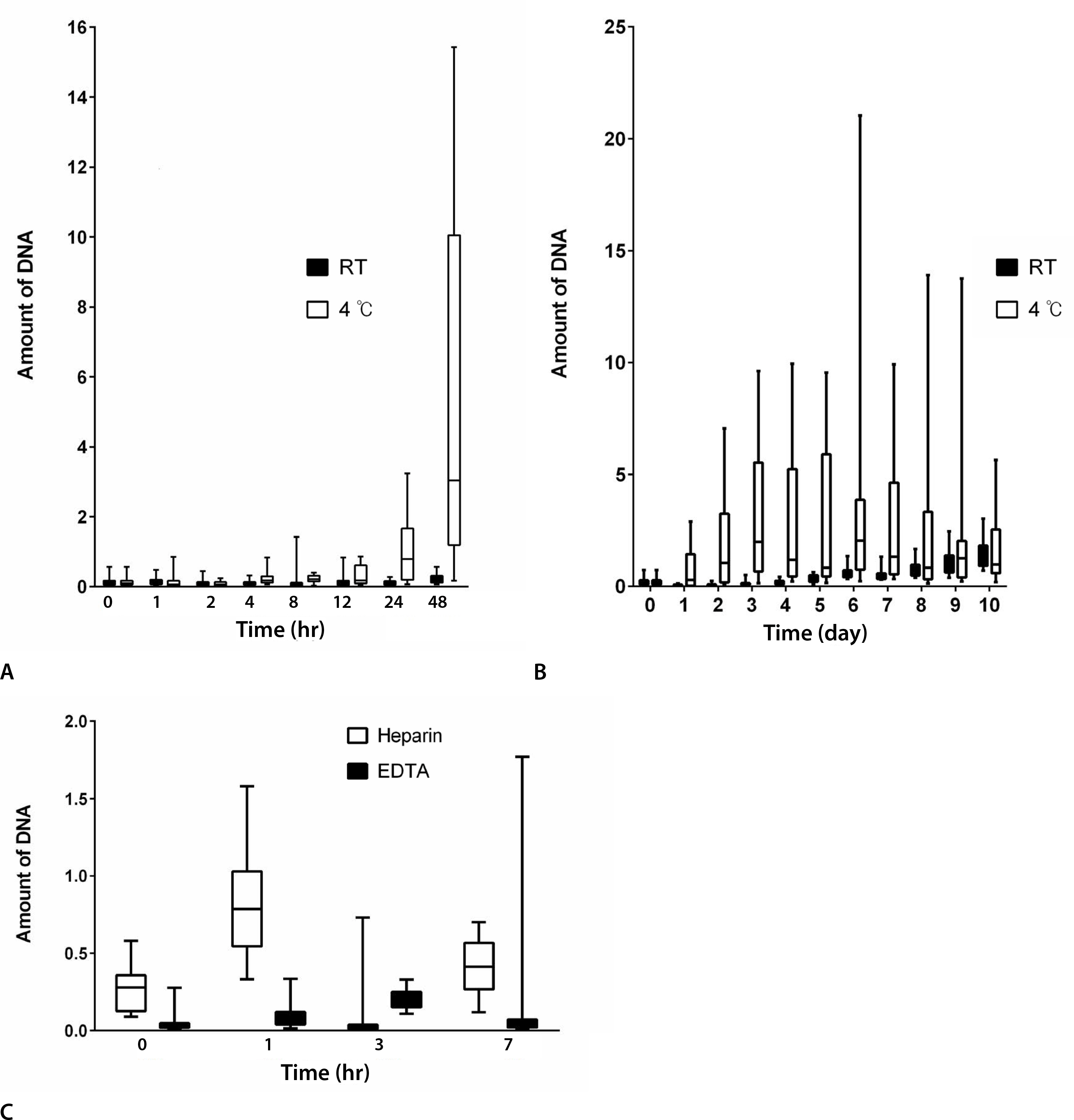Korean J Leg Med.
2016 Aug;40(3):78-82. 10.7580/kjlm.2016.40.3.78.
Factors Affecting DNA Yields from Serum and Plasma Samples Used for Personal Identification Testing
- Affiliations
-
- 1Department of Forensic Medicine, Seoul National University College of Medicine, Seoul, Korea. sdlee@snu.ac.kr
- 2Institute of Forensic Science, Seoul National University College of Medicine, Seoul, Korea.
- KMID: 2350695
- DOI: http://doi.org/10.7580/kjlm.2016.40.3.78
Abstract
- Serum or plasma is free of cellular components. As DNA is in the nucleus or mitochondria of a cell, it can be presumed that serum/plasma is DNA free. However, there are cases wherein serum/plasma is the only resource available for identification analysis, yet no sufficient data are available regarding whether reliable DNA testing can be applied to such cases, and what the influencing factors are when testing is a valid course of action. The aim of this study is to illustrate the factors that can be used in the genetic testing of serum/plasma when identifying an individual. The results showed that the concentration of serum DNA significantly increased over time in 4℃ storage, and the DNA yields from samples stored in heparin tubes were overall higher than from samples stored in ethylenediaminetetraacetic acid tubes. We observed that the concentration of DNA in serum successfully matched 100% to the short tandem repeat data of blood DNA.
Keyword
MeSH Terms
Figure
Reference
-
1.Lo YM., Tein MS., Lau TK, et al. Quantitative analysis of fetal DNA in maternal plasma and serum: implications for noninvasive prenatal diagnosis. Am J Hum Genet. 1998. 62:768–75.
Article2.Lee JH., Lee HY., Cho S, et al. DNA profiling via short tandem repeat analysis by using serum samples. Korean J Leg Med. 2013. 37:220–3.
Article3.Takayama T., Yamada S., Watanabe Y, et al. Origin of DNA in human serum and usefulness of serum as a material for DNA typing. Leg Med (Tokyo). 2001. 3:109–13.
Article4.Honda H., Miharu N., Ohashi Y, et al. Fetal gender determination in early pregnancy through qualitative and quantitative analysis of fetal DNA in maternal serum. Hum Genet. 2002. 110:75–9.
Article5.Bischoff FZ., Sinacori MK., Dang DD, et al. Cell-free fetal DNA and intact fetal cells in maternal blood circulation: implications for first and second trimester non-invasive prenatal diagnosis. Hum Reprod Update. 2002. 8:493–500.
Article6.Allen RW., Pritchard JK. Resolution of a serum sample mix-up through the use of short tandem repeat DNA typing. Transfusion. 2004. 44:1750–4.
Article7.Lam NY., Rainer TH., Chiu RW, et al. EDTA is a better anticoagulant than heparin or citrate for delayed blood processing for plasma DNA analysis. Clin Chem. 2004. 50:256–7.
Article8.Ravard-Goulvestre C., Crainic K., Guillon F, et al. Successful extraction of human genomic DNA from serum and its application to forensic identification. J Forensic Sci. 2004. 49:60–3.
Article9.Barra GB., Santa Rita TH., Chianca CF, et al. Fetal male lineage determination by analysis of Y-chromosome STR haplotype in maternal plasma. Forensic Sci Int Genet. 2015. 15:105–10.
Article10.Sedlackova T., Repiska G., Celec P, et al. Fragmentation of DNA affects the accuracy of the DNA quantitation by the commonly used methods. Biol Proced Online. 2013. 15:5.
Article
- Full Text Links
- Actions
-
Cited
- CITED
-
- Close
- Share
- Similar articles
-
- Identification of Fetal Gender Using Maternal Plasma DNA
- When Can We Identify Fetal Male Gene By Using Maternal Plasma DNA?
- Evaluation of Intact Parathyroid Hormone Levels in Plasma Samples: A Comparative Study Using Serum Samples
- The Significance of Sample Preparation in Measurement of Ionized Calcium
- Prevalence of HBV DNA in Packed Red Blood Cells



